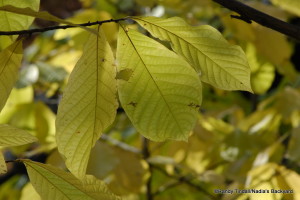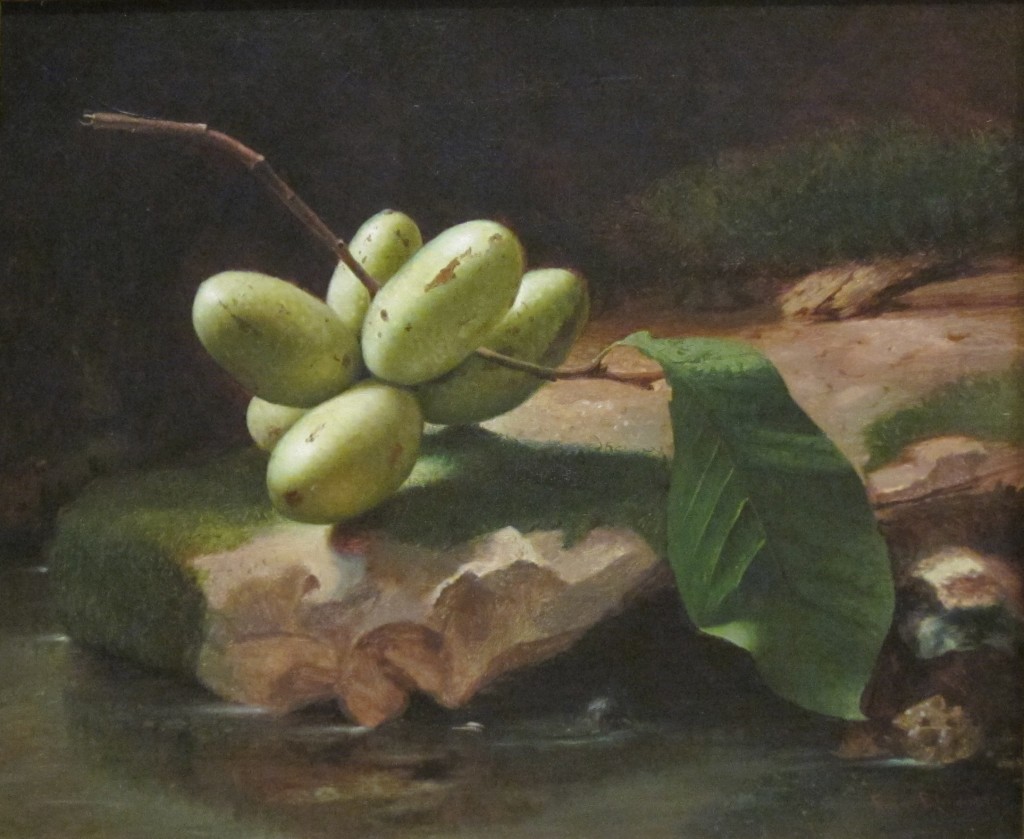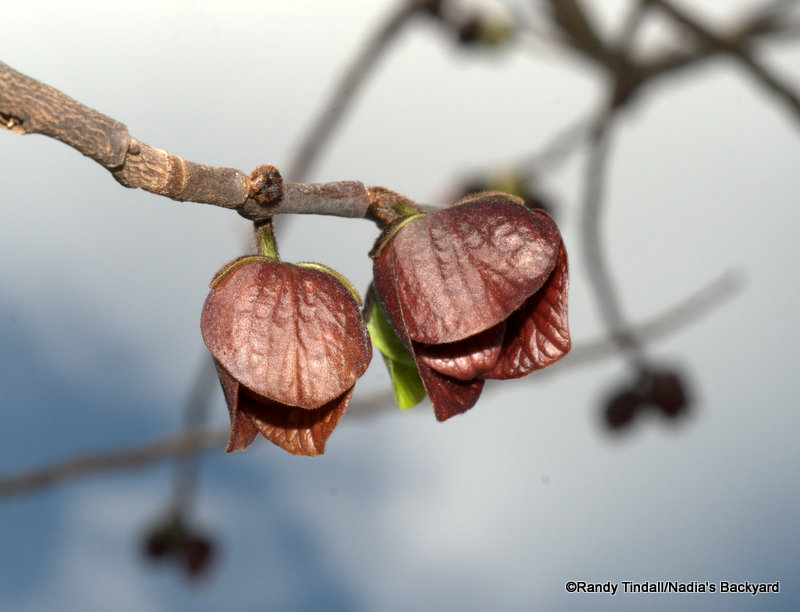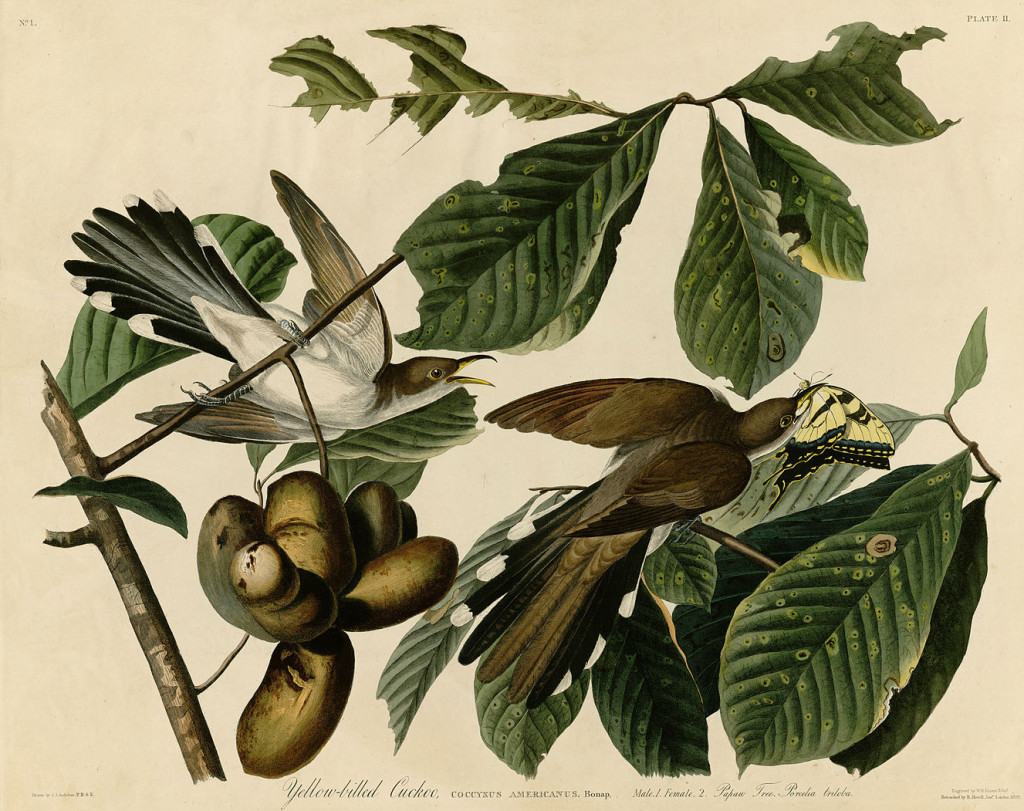Hernando De Soto would have felt right at home in our yard.
He might have, at least, if he had made it farther north in Missouri and seen the pawpaw tree growing next to our house. Since his little camping expedition in the 16th century may have been the first to record Asimina triloba in the New World, and he seemed to be a great admirer of its odor and taste, he might have hunkered down here a bit for a snack.
But I’m pretty sure he didn’t. A mammoth might have, though. More on that later.
We are fond of our pawpaw, which nestles up against our persimmon tree just across the fence and intertwines branches with it. It’s an attractive small to medium-sized tree with large and pretty leaves, which add a splash of color in autumn as they turn a predictable shade of yellow each year.
This species has wandered farther north than its mostly tropical kin, grows up to about 30 feet tall and seems to like moist areas, such as along rivers and creeks or along the bases of bluffs. Even so, it made it through the Great Drought a couple years back without any supplemental watering. Ours is on the shady north side of the house and tolerates even deep shade in the wild. I suspect that if it had been in a sunnier location during the Dry Spell, it might not have been quite so complacent.
The pawpaw grows through much of the midwest, eastern and southeastern United States and even extends up into a bit of southeastern Canada . In Missouri it is found pretty much everywhere except possibly in some far northern counties. Since it doesn’t require much maintenance and has an attractive appearance, it is finding its way into more and more yards, especially once people find out about its fruit, which is not only very tasty but is the largest native fruit in North America.
This fruit, also sometimes called the “Missouri Banana”, among other nicknames, grows along the branches in clusters and looks a bit like a mango (to me, at least), starting out green and turning yellowish to purple as it ripens through September and October in Missouri. At least it does if there’s another pawpaw somewhere around, because the tree doesn’t generally self-pollinate. Our own tree has only produces a few fruits, so we may need to plant another sometime. Apparently its partner-in-pollination (which may be down at the end of our street, eight houses away) is too far to result in a torrid romance and loads of fruits. Ideally, there should be another tree close enough for insects to transfer pollen easily to yours and preferably the trees should originate from different areas or be of different varieties (if growing commercial strains).
The main pollinators seem to be blowflies and other carrion feeders, which may be why the flowers are sometimes said to have an odor (thankfully very faint) of rotting meat. It is said that some pawpaw growers actually attract pollinators by hanging meat or chicken necks in the trees or by spraying fish emulsion on the flowers. We do not. I think even our fine neighbors have limits to their tolerance.
The taste of this fruit has been described as being like various combinations of banana, pineapple, papaya and pineapple, with the consistency of custard when ripe. (Hence, I suppose, the reason for the name “custard apple” for the Annonaceae family which includes the pawpaw.) Nutritionally, the pawpaw fruit is reported to be equal or superior to many other fruits, including apples, bananas, peaches and grapes. It’s eaten raw (if you can get to it before the wildlife does!) or made into ice cream, pies or cakes. Recipes abound. (One is abounding below.)
Ripeness is often best judged by the softening of the fruit, rather than by color changes, since the edibility window is fairly narrow. Ripe fruit may be kept in the refrigerator for up to a week and unripe fruit may last as long as three weeks when kept cold, then ripened at room temperature. Left to its own devices, the fruit ripens, over-ripens and begins to ferment in just a few days, which has so far limited its potential as a crop. That is changing, though, as efforts are underway to develop varieties more suitable for commercial use. It is already being grown commercially in Ohio and research is being conducted in other states, including Missouri, on developing varieties for both fruit and ornamental use.
So why else would you want this pretty little tree around? The wood’s not good for much, but it will yield fibers that have been used as fish stringers, just in case you forget yours sometime and happen to be fishing under a wild pawpaw tree.
It’s kind of smelly—not only the flowers, but the bark, leaves and twigs also have disagreeable odors when bruised, but that’s not all bad. It seems that those latter odors come from acetogenins that have some powerful potential applications.
In journalspeak: “The powerful cytotoxicity, in vivo antitumor, pesticidal, antimalarial, anthelmintic, piscicidal, antiviral, and antimicrobial effects indicated a myriad of potentially useful applications……Successful applications and commercial products include a shampoo, highly effective in treating infestations of head lice, fleas, and ticks; a series of pesticidal sprays, which protects host plants against a diversity of pests; and an ointment for treatment of oral herpes (HSV-1) and other skin afflictions…… In addition, an encapsulated extract has been effectively used by certain cancer patients as a botanical supplement product.”
Now, why would you NOT want that around? I mean, really.
Also for butterfly aficionados, this is THE go-to plant for Zebra Swallowtails, whose caterpillars are among the few insects that actually munch on this tree. Those acetogenins mentioned above do for Zebras what milkweeds to for Monarch butterflies, by making them distasteful and toxic to predators. The feeding of the caterpillars on the smelly leaves confers a lasting protection throughout the lifetime of the larvae and even the adults, who will return to lay eggs on those same leaves. Sometimes they can be quite insistent about that.
The presence of this tree can almost guarantee that you will have some of these gorgeous butterflies around to brighten up the surroundings. We do!
Oh, yeah, about those mammoths. One of the puzzles about pawpaws is how they were disseminated in the past. One school of thought is that pawpaw is an “anachronism” of earlier times and the most likely candidates for dispersal were the megafauna of ancient North America, the “ghosts of evolution”, including mammoths, mastodons and others, who ate the fruits, passed the seed through their digestive tracts and deposited them with a copious load of fertilizer at a distance. Of course, we all know what happened to those creatures when a certain biped strode into the neighborhood with its formidable hunting skills and tools. The pawpaw, fortunately, was awfully tasty to those early human immigrants, too, so it may be that they took over spreading the tree around by actively planting it to ensure a good supply. Even so, it may be that the tree learned to send up lots of root suckers to keep clones of itself going, just in case it wasn’t able to propagate by seed. (It is certainly working hard on that in our yard.) At any rate, it has survived and even thrived.
The pawpaw not only helped to feed De Soto, but was apparently a favorite of George Washington, and helped Lewis and Clark get through some lean times. It has provided seasonal nutrition and treats to generations of people who live close to the land. In Missouri, there is even a rather shy, remnant cultural group on the edge of the Ozarks who spoke a dialect of French and were jokingly said to have relied on them for lack of funds to eat much else.
“Speakers of the dialect called themselves Créoles. They were sometimes known as “paw-paw” French, a term used at least sometimes in self reference. The name has been described as a ‘fun-loving insult’ referring to a French creole ‘so poor that he lived on pawpaw in the summer and possum in the winter’.”
They are still proudly there, although the dialect is fast fading away. I don’t know if they still eat pawpaws, but there are plenty of them to eat if they look for them and are quicker than the wildlife that compete for them.
So get yourself “Way Down Yonder in the Pawpaw Patch” and gather some fruit. Save the seed and plant a couple trees yourself or contact your nearest native plant nursery to see what they have for you.
The mammoths are gone. It’s up to us now.
————————————————————————————————–
Pawpaw Ice Cream
(From “Where To Get Your Taste Of The Pawpaw” by Allison Aubrey)
Makes about a pint
2 cups heavy cream
1 cup milk
1/2 cup sugar
1 teaspoon vanilla
1/2 teaspoon lemon zest
1 cup pawpaw pulp
Juice of 1/2 lemon
Heat the cream, milk, sugar, vanilla and zest in a saucepan until the sugar dissolves. Strain, cover and cool immediately.
Mix lemon juice into pawpaw pulp and set aside.
Once the cream mixture is cool, put it in the ice cream maker. With about 10 minutes remaining in the process, slowly add the pulp and let it combine. Freeze according to manufacturer’s directions.








Thank you for the information, I have been trying to find a paw paw tree for the Zebra Swallowtail Butterflies. I had one visit last year with the Black Swallowtail Butterflies. I also have milkweed and a charm of hummingbirds.
Great! Keep planting those wildlife-friendly plants, and thanks for reading!
This is great information. I’m going to start a pawpaw patch for my grandchildren.
Great idea! Thanks for reading!